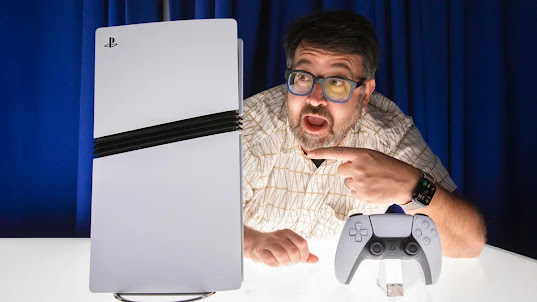PlayStation 5 Pro Hands-On First Look: Here's What I Learned
Exclusive: I checked out the new console upgrade, coming Nov. 5 for $700, and played a bunch of games. Here's who might appreciate the new graphics boosts the most.
Surprise: The PS5 Pro isn't actually that big, but it does have a big GPU upgrade.
Editors Note Nov. 6, 2024: We have published a full review of the Sony PlayStation 5 Pro. This hands-on has not otherwise been updated.
Sitting in front of an 80-inch TV playing Gran Turismo 7 is an immersive experience. It's even more realistic in 8K resolution. I'm not a good driver, but that's partly because I'm stunned by the clarity of the vistas in front of me. I'm also wowed by a new 4K ray-tracing mode that casts car reflections on other racers. It feels almost like I'm in VR without the headset. But would the average person be able to tell the difference? I kept wondering that both during and in the week after my exclusive demo of the PlayStation 5 Pro.
I went to Sony's PlayStation headquarters in San Mateo, California, and spent time in a room full of TVs, all running demos of familiar games such as Ratchet & Clank and Spider-Man 2. These demos were all playing on the new PlayStation 5 Pro, arriving Nov. 7 for $700 (£700) with preorders starting Sept. 26. Mark Cerny, Sony's lead PlayStation system architect, guided me around the demos, pointing out the Pro upgrades compared to the standard PS5 on a side-by-side monitor.
As I jumped back and forth, I could see the difference. Everything is crisper, more fluid or both. I'd prefer to play on the PS5 Pro. With a non-Pro PS5 available for $500 today and likely less during upcoming holiday sales, I don't know if the sometimes subtle upgrades will be worth the price for many. The PS5 Pro is not the PlayStation 6, which likely won't be released for another three or four years, and it isn't for everyone. It's a big, graphically boosted piece of hardware that can keep up with ever-changing PCs and, in some ways, maybe exceed them.Similar in size with turbo-style vents
I was shocked that the PS5 Pro wasn't a hulking beast. The console's contours are nearly the same as the original PS5, and it's actually smaller. Meanwhile, the "Slim" PS5, released last year, is definitely smaller than the Pro but the difference in size isn't massive.
The biggest external differences, teased in Sony's 30th-anniversary logo, are the diagonal black ribbed vents across the center. (These mean the Pro is incompatible with existing PS5 console covers.) The front and rear ports on the Pro shipping in November are the same as the current PS5, but the prerelease hardware I saw on display during my demo had an extra USB-C port in the back instead of USB-A. The final hardware will have USB-C ports on the front and USB-A ports in the back. The PS5 Pro should slot into similar shelving to your older PS5, unlike the chunkier PS4 Pro released in 2016, and you can mount the Pro vertically on the optional $30 stand if you prefer.
The Pro comes with the same DualSense controller as the PS5 -- no upgrades there. (A step-up DualSense Edge controller already exists.) The Pro doesn't have an optical disc drive. Instead, there's a larger 2TB solid-state drive, plus the same support for expanded M2 SSDs. You can attach an optical drive separately, the same ones that work on the new PS5 models. You could detach one of those or buy a new one. Not having an included optical drive standard feels like a statement that downloadable games are now the standard, and the Pro's bumped-up Wi-Fi 7 support should make for faster downloads if your router supports it.
Also an Apple fan? Here's the iPhone 16 pricing, sale date and preorder info you're looking for.
Gaming perks: Bigger GPU, 4K and 60fps, lots of ray tracing
Everything the PS5 Pro offers is about graphics. The CPU is the same as the PS5, and so is the SSD speed. The GPU, meanwhile, has 67% more computing cores, according to Sony, with 28% faster RAM and 45% faster rendering.



Comments
Post a Comment